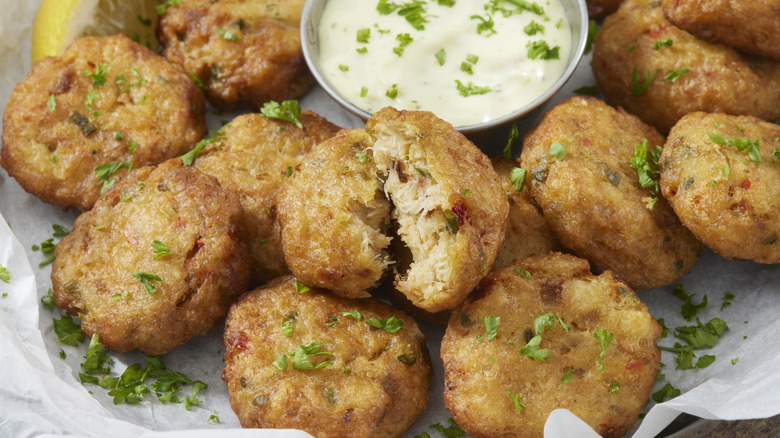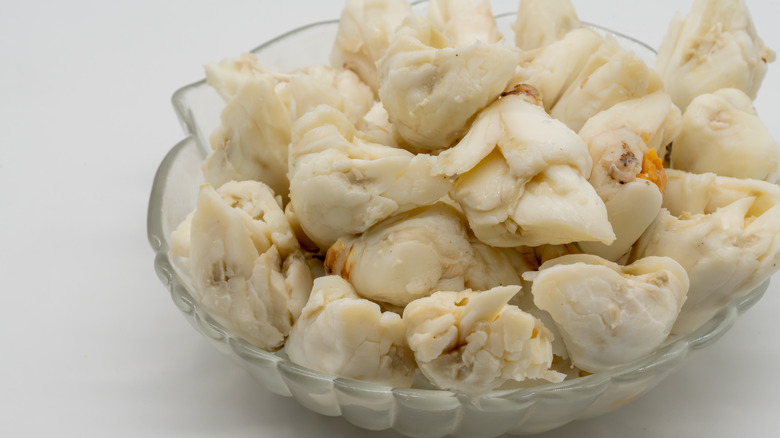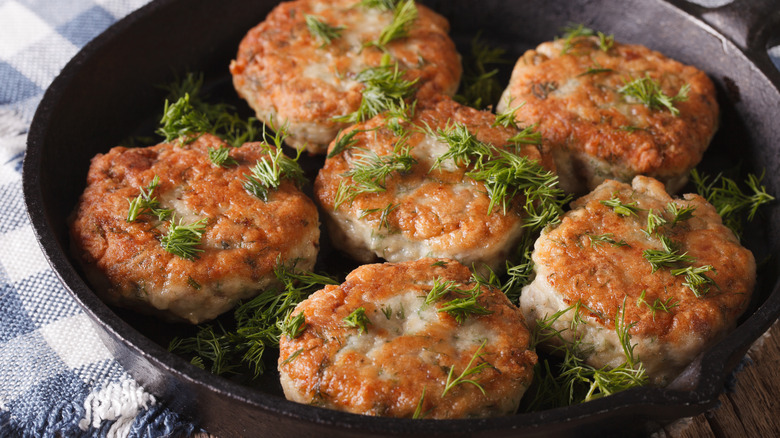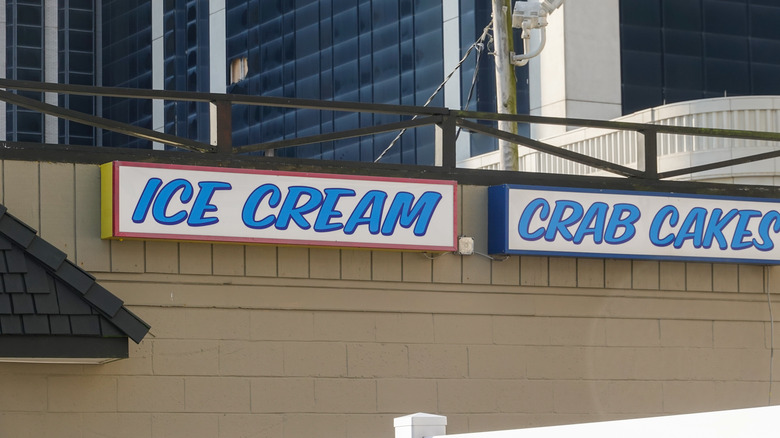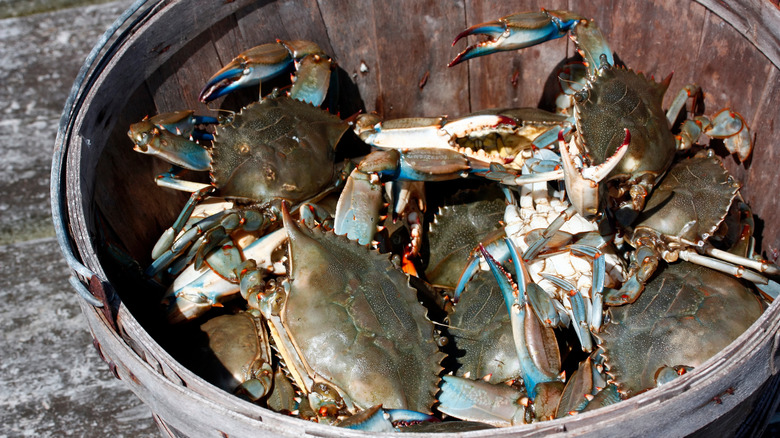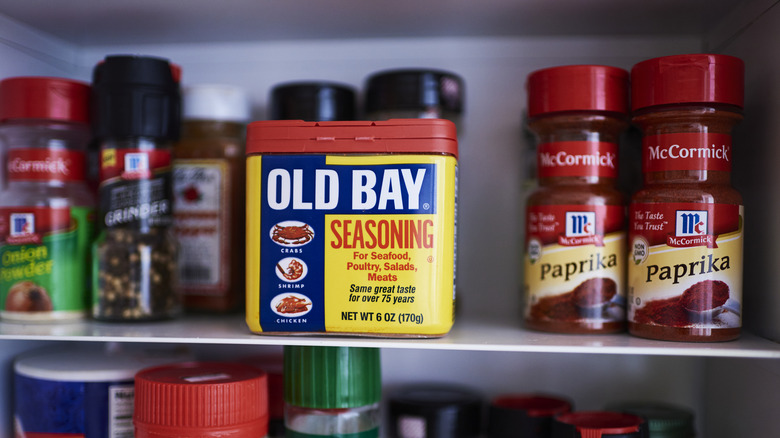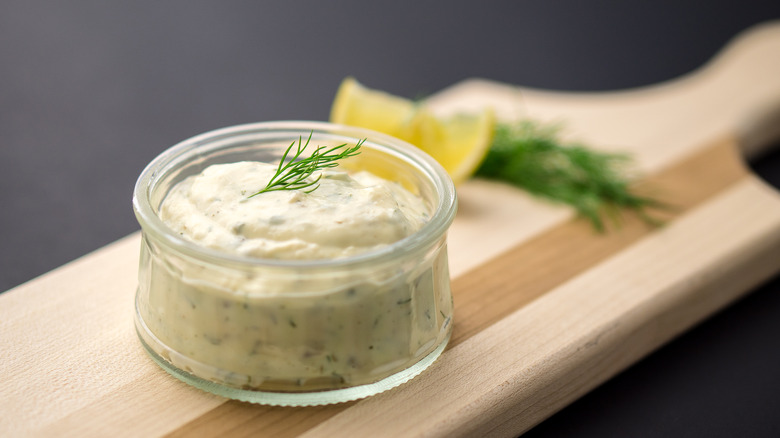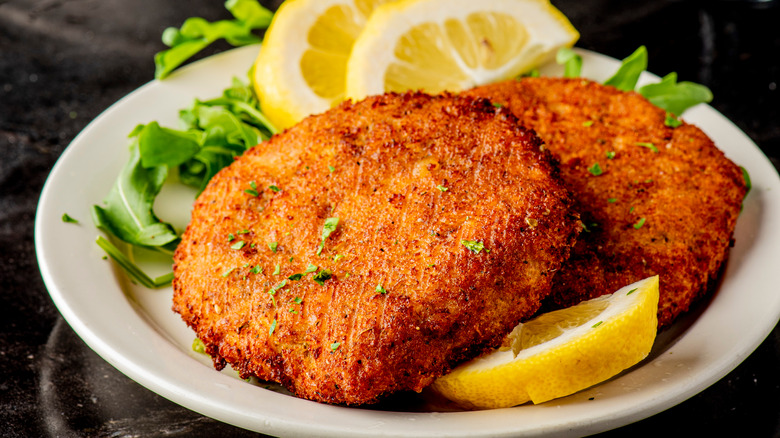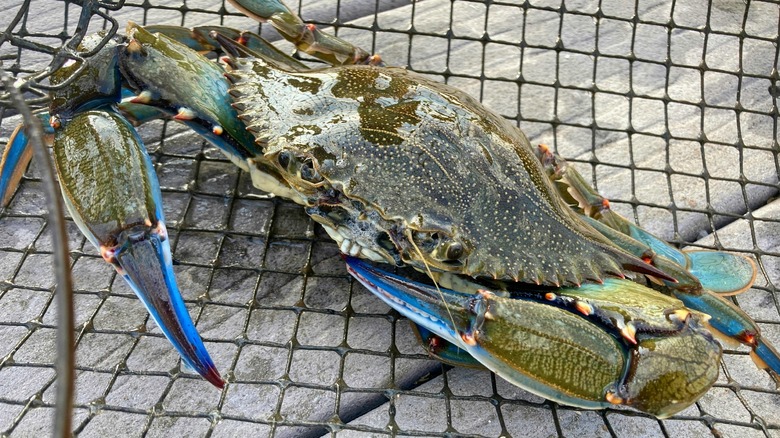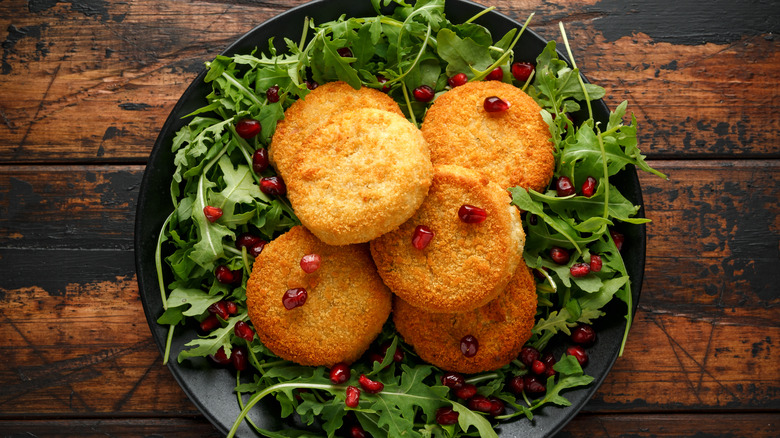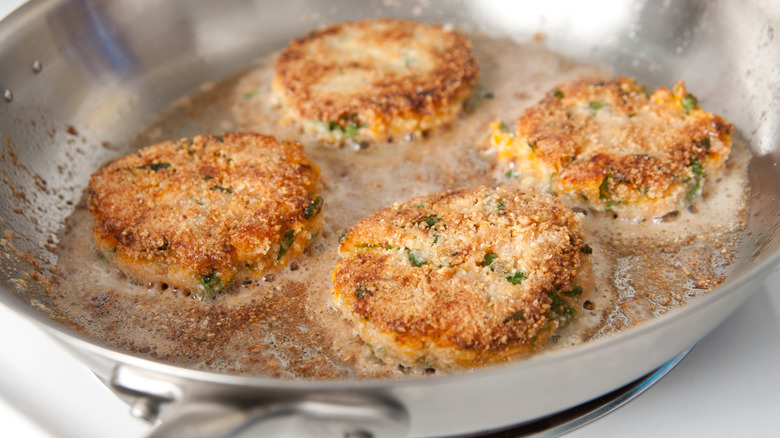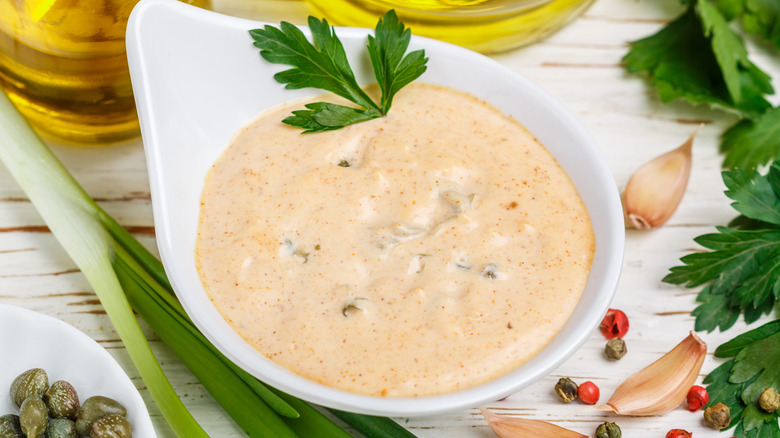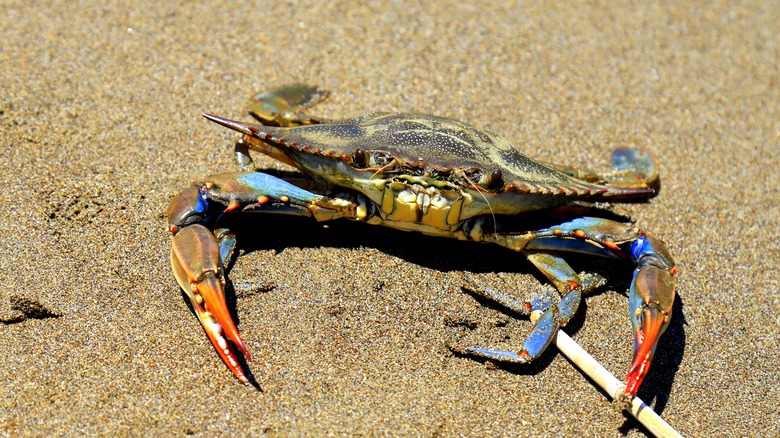Maryland Vs Louisiana Crab Cakes: Everything You Need To Know, According To Chefs
When it comes to crab cakes, there are multiple schools of thought, but self-described "Maryland boy" Andrew Cleverdon, Chef de Cuisine at Blue Duck Tavern, is adamant that his local iteration reigns supreme. Growing up with an avid sailor for a father, he recalls that "we ate at many small shacks, crab-houses and mom and pop operations throughout the watershed." What resulted was a real love of the Chesapeake — and the crab cakes that give a starring role to the bounty of its waters.
A bit further south, however, fans of Louisiana crab cakes won't let their version be kept in the shadows. Here, Gulf crab meat is seasoned with a far heavier hand for cakes that are crispier, spicier, and slightly less expensive than Maryland's crab-laden behemoths.
"Real fresh Maryland crab is very pricey, especially the prized jumbo lump," says Maryland native chef Matt Smith, Chef de Cuisine of Alta Strada Mosaic by chef Michael Schlow. "Home cooks just need to prepare for the price tag shock and have faith that the end result will be worth it." And there are other ways to curtail the cost. Chef Michael Correl from Ruse recommends combining jumbo lump crab with backfin meat, the latter a delicacy he seems to be his favorite.
But price is not the only thing that divides these two crab cake categories. We spoke to a host of experts including top chefs working on the ground to discover all the differences between Maryland and Louisiana crab cakes.
Maryland crab cakes have very little filler
Perhaps the chief defining factor of a Maryland crab cake is its short ingredients list. Here, jumbo lump crab from the Chesapeake is the star. "It is kept simple, not out of a lack of sophistication or culinary skills but out of respect and admiration," says Cleverdon. He says all the blue crab meat needs is a touch of mayo and a bit of binder to hold it all together. For Cleverdon, that last ingredient comes in the form of crushed crackers, either Ritz or saltines. Correl, meanwhile, prefers Italian breadcrumbs, which his mother used when he was growing up. Either way, it is best to be judicious with anything that isn't crab. "People in MD want to see the crab and will call you out if there is too much filler," says Correl.
Smith echoes these instructions, noting that a crab-forward cake is a star of Maryland cuisine. "Crab cakes from other areas tend to be heavy with breading and filler like bell peppers and panko crumbs for example," he explains. When making Maryland crab cakes, chef Mike Fearson of The Choptank Annapolis likewise notes that "you should never have more binder than crab."
That said, it's important not to err too far in the other direction, lest it all crumbles. "You still need a small amount of binder to hold the crab meat together," Fearson adds. "If your ratio is too low, the crab cake will be loose and fall apart."
Maryland crab cakes can be cooked in multiple ways
The chefs we spoke to are pretty clear about the rules of what goes into a Maryland crab cake, but they're a bit more divided when it comes to how to cook one. According to Fearson, crab cakes in Maryland are typically baked, though he has a soft spot for those that are fried. "The flavor comes out a little more with a crisp outside and moist filling inside," he says of the fried variety.
Smith, meanwhile, argues that the most traditional cooking method is to broil cakes with clarified butter, though frying is a possibility — "in peanut oil preferably." Correl echoes this sentiment, noting that he prefers his crab cakes broiled, too. He argues frying tends to make the cakes overly dense and can bring too much oil to the party. Chef Oscar Benitez of Spain Wine Bar in Ocean City, Maryland also prefers baked cakes, noting that while frying, baking, or grilling each has their proponents and unique textures, "I prefer mine baked with a little bit of charred soft crust on top."
Cleverdon likes his cakes cooked gently on the stovetop. "It should be colored softly in a pan with a splash of oil or butter and flipped and put in a moderately hot oven to heat through," he says. The resulting cake should have "supple" edges and a moist, juicy interior. "It should never be fried or 'crispy,' " he notes.
Maryland crab cakes may be made boardwalk style
In addition to a classic Maryland crab cake, there is another approach, though admittedly even our Maryland-based chefs are unfamiliar with it. Cleverdon, however, knows his way around a boardwalk crab cake, which he says was popularized by Philips Seafood restaurants. It tends to be more generously seasoned than a classic Maryland crab cake and typically boasts more filler. "Boardwalk crab cakes usually have egg and breadcrumb to hold them together and thus need more 'seasoning,' " explains Cleverdon. "They are breaded lightly and fried. While they are not bad, they certainly are far from the best."
But, despite Cleverdon's skepticism, there's a reason why boardwalk crab cakes are popular: economy. This style of cake takes advantage of smaller, sweeter bits of crab instead of the spendy jumbo lump meat, leading to a more affordable crab cake. What's more, the use of additional filler to hold these bits of crab together cuts down on the cost even further. "With the different meat the cake is more 'shredded' and less 'chunky,' " he says. Ultimately, this style of Maryland crab cakes is certainly more cost-effective, but they do depart a bit from tradition.
Maryland cakes are typically made with local Chesapeake crab
The star of a true Maryland crab cake is the bounty of the Chesapeake Bay, something that turns Cleverdon into a veritable poet. "Crab cakes are to Maryland and the Bay the way blue is to the sky," he says. "It is a celebration of that single ingredient, Callinectes sapidus. The beautiful swimmer. The Blue Crab."
Chesapeake blue crab stands out not just for its terroir, but also for the fact that it's a species with distinct flavor. Blue crab boasts more delicacy and sweetness than most other crustaceans, with briny, even buttery notes. The only problem? Blue crab has a season ... yet hungry people demand Maryland crab cakes all year round.
"Chefs who decide to offer crab cakes year round go through a gapping period in the off-season where Venezuelan meat is often substituted," explains Smith, "but it is still offered as an MD crab cake because of the blue crab being used and the same methods of preparation."
This isn't strictly cheating, according to Fearson, who argues that what makes a Maryland crab cake is indeed the recipe. "It's the style of the crab cake mix that makes it Maryland-style," he says. "As long as you are using blue crab, the meat does not need to come from the Chesapeake Bay." But for Correl, swapping crabs of another origin is poor practice. "Whenever I serve crab on my menu," he says, "I only buy local crabmeat."
Maryland crab cakes are usually seasoned with Old Bay
Maryland crab cakes keep their seasoning like they keep their filler: minimal. According to Cleverdon, all a sweet blue crab needs to shine is salt, lemon zest, and "maybe a pinch, A PINCH!, of JO or Old Bay."
Old Bay may be a cupboard staple even if you're not from Maryland, with its time-honored combo of celery salt and spices. While the exact blend is kept secret, many a home cook has attempted to create copycat Old Bay by combining celery salt, paprika, black pepper, cayenne, and warming spices like nutmeg, cinnamon, and ginger. The resulting seasoning "helps Maryland crab cakes to stand out," according to Fearson. "Old Bay's notable blend of seasonings makes a real difference in the overall flavor once combined."
J.O., meanwhile, is more of an insider's choice with a similar proprietary blend of spices. "Folks from MD historically argue on the use of Old Bay versus JO seasoning," says Smith. "It all depends on your family recipe and what area you grew up in." When the Baltimore Sun did some on-the-ground reporting, it found that 18 of 30 local crab houses contacted use a type of J.O. seasoning, while only one used Old Bay. Smith, however, opts for the latter. "I still make my Crab Cakes the same way I was taught from my first chef in Baltimore twenty-five years ago," he says. He uses Old Bay, egg yolk, lemon juice, yellow mustard, Worcestershire, Tabasco, and parsley.
Maryland crab cakes are typically served with tartar sauce
Maryland crab cakes are certainly delicious enough to stand alone, but most of the time, you will find them served with a side sauce. While there are loads of choices, Smith believes that tartar sauce is "the most appropriate" option of them all. This sauce, which is generally made with a combo of mayonnaise, chopped pickles, capers, parsley, lemon, salt, and pepper, couldn't be easier to make at home. Even better, it marries wonderfully with a wide variety of seafood, including crab cakes.
But tartar sauce is not the only choice at your disposal. Some diners, Smith says, prefer cocktail sauce, a sweet and sour blend of ketchup, lemon juice, Worcestershire sauce, and prepared horseradish. Fearson, meanwhile, likes to serve his crab cakes with two sauces: an aioli-style sauce crafted from a mayonnaise base and, alongside that, a simple yellow mustard, which he says brings out the flavor of the crab beautifully.
Then again, many claim that with crab cakes that are this good, there's always the option to dig into them with nothing on them at all.
Louisiana crab cakes boast big flavors
Louisiana also boasts its own style of crab cake and like much of the food from this state, it's known for some seriously big and bold flavors. Typically seasoned with the Cajun and Creole holy culinary trinity of onion, celery, and bell pepper, Louisiana crab cakes may also include green onion, jalapeño, parsley, bay leaf, cayenne, and hot sauce. Louisiana crab cakes can get additional flavor from Creole mustard, which takes advantage of multiple culinary influences from around the globe. It uses a mix of stone-ground mustard sweetened slightly with honey and molasses and spiced with hot sauce, horseradish, and Creole seasoning. The latter spice mix is also a popular addition to Louisiana crab cakes, combining a complex lineup of paprika, oregano, thyme, garlic powder, onion powder, ground cayenne pepper, black pepper, white pepper, and salt.
But seasonings are not the only place where a Louisiana crab cake may depart from the crab-heavy Maryland recipe. Louisiana crab cakes may feature other shellfish in the mix, like shrimp. "I have even heard tell of sometimes having conch in there," says Cleverdon. "Why they would do that is beyond me .... maybe they ran out of crab."
Though it's a keen departure from the crab cake approach in Maryland, there's no denying there's a lot more flavor in this take on the dish.
Louisiana crab cakes are made with blue crab from the Gulf of Mexico
Because Louisiana is far closer to the Gulf of Mexico than the Chesapeake Bay Gulf crabs are preferred in the southern state. While there are blue crabs in the Gulf, these crustaceans are cheaper and often larger than Maryland crabs. According to many experts, they just don't compare when it comes to flavor. Perhaps this is why recipes for Louisiana crab cakes rarely focus quite so much on a particular crab species, with some even going so far as to say that you can use imitation crab in place of the real thing.
Given this approach, it's perhaps no surprise that Louisiana crab cakes are seasoned so heavily. According to Cleverdon, this style is made with "a tremendous amount of spice." With local Chesapeake crabs, he says, you want the flavor of the crab to shine on its own. If the crab is of lesser quality, it's less problematic — and frankly cheaper — to let less onerous ingredients do more of the heavy lifting.
Louisiana crab cakes have more binder
Unlike Maryland crab cakes, which are often just barely held together with breadcrumbs or crushed crackers, Louisiana crab cakes boast some real heft thanks to binders. In addition to the generous seasonings and aromatics, the latter of which already lends a bit of texture and bite, a Louisiana crab cake is typically bulked out with more starch than the Maryland variety. This can come in many forms, whether it's the crushed crackers that can also be detected in many a Maryland crab cake or fresh breadcrumbs, dry breadcrumbs, or Japanese-style panko.
Eggs and mayonnaise are often thrown into Louisiana crab cakes as additional binders. This doesn't just add moisture to the mix but also lends protein that helps the crab cakes stay together. These additions make the mixture a bit easier to form into cohesive patties, an especially nice factor for inexperienced home cooks. This ultimately results in a crab cake with a bit more structure and texture than the iteration that hails from Maryland.
Louisiana crab cakes are usually breaded and fried
Before they are cooked, Louisiana crab cakes are typically dredged in seasoned cornmeal or another layer of breadcrumbs, either of which provides not only an additional opportunity for seasoning but paves the way for a far crispier texture than the pillowy tenderness that Maryland crab cakes are known for. This holds doubly true when you consider how Louisiana crab cakes are typically cooked. Unlike the Maryland iteration, which is most often broiled or gently pan-seared, Louisiana crab cakes can take a bit more heat.
Louisiana-style crab cakes "are almost always dredged in cornmeal or breadcrumbs and fried harder than even a boardwalk crab cake," says Cleverdon. The comparison to boardwalk crab cakes is apt. Shallow frying Louisiana crab cakes isn't just delicious but also makes them easier to handle and also gives them a lovely crispy crunch that contrasts beautifully with the ideally tender interior.
Louisiana crab cakes are often served with remoulade
Louisiana brings more flavor to the table where dipping sauces are concerned, as well. "In Louisiana they often eat their crab cake with a regional interpretation of the French sauce remoulade," explains Cleverdon. Indeed, whereas French remoulade is typically made with a simple combination of a mayonnaise base that is then seasoned with shallot and mustard, Louisiana remoulade packs a big punch. This variety marries mayo with a long ingredients list that usually includes garlic, mustard, lemon, Creole seasoning, hot sauce, horseradish, smoked paprika, black pepper, and chopped pickles. Smoky and spicy, Louisiana remoulade also often boasts a pretty pink color thanks to the inclusion of paprika. It is a beloved accompaniment for Louisiana staples like po' boy sandwiches as well as "pretty much anything fried," according to recipe developer Molly Madigan Pisula.
When it comes to crab cakes, even native Maryland chefs can get behind it. "I have to admit, I like creole remoulade sauce and think it offers a delightful contrast," Cleverdon says. However, he appends that it's best enjoyed "when eaten with a Maryland Crab Cake."
Methodology
To help us wrap our heads around the many differences between Louisiana and Maryland crab cakes, we went straight to the source: the chefs who create crab cakes all the time! Many of our chefs hailed from Maryland, so as to not give that state's version of crab cakes too much of an advantage, we also consulted trusted research sources to get our info.
